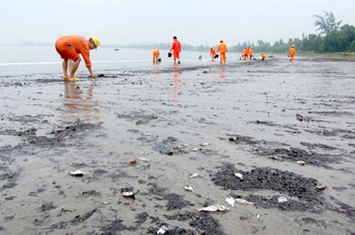Scientists have warned that not only fresh water areas have been polluted, but sea water is also bearing a similar hard pressure.
 The waste water from residential quarters is following the canals and rivers to flow to the sea, while the operational water treatment systems are not capable enough to treat the waste water. The risk of sea water getting polluted has become more serious, experts say.
The waste water from residential quarters is following the canals and rivers to flow to the sea, while the operational water treatment systems are not capable enough to treat the waste water. The risk of sea water getting polluted has become more serious, experts say.
A recent survey by the General Environment Department has pointed out that the coastal sea water areas are being put under hard pressures, especially the pressure from the population increases and the development of coastal urban areas.
According to the department, every day, the urban areas discharge 5200-10,300 tons of waste to the sea, and thousands of tons of untreated dangerous waste, including suspended solids, BOD5, COD, and lubricants. Especially, the industrial waste water from the shipbuilding industry contains a high concentration of mineral oil, cleansing chemicals and heavy metals which seriously threaten the quality of sea water.
The survey has found out that in recent years, at the Haiphong-Quang Ninh port complex, 400 ships leave the ports per month, leaving thousands of tons of the mixture of waste water and oil. Especially, the collusions of ships on the sea, which cause to the leaking of chemicals, have also threatened the sea environment.
Meanwhile, a lot of people’s activities, including the aquaculture, sea industry development and tourism project development all have also made the sea dirty.
All the above said factors have led to the sea water quality degrading, which experts have warned, will lead to the pollution of the sea water in a near future.
There are different signs of the sea pollution, including the increases of the concentrations of the polluted substances in the sea water, such as oil, heavy metal and toxic substances, the increases of polluted substances gathered in the sediment of the coastal areas, the degrading of the sea ecosystem including the coral ecosystem, mangrove forest ecosystem or sea weeds, the decreases of the sea creature species and the biology diversification.
Other signs include the appearance of the phenomena of red tide, and the gathering of polluted substances in seafood.
According to the Oceanography Institute, the corals and sea weed cover, the main supplies of food for aquatic creatures, all have been seriously declining.
Vietnam is considered the country with a large sea weed cover area in the world. The covers, located at the depth of 0-20 meters, are the places for many aquatic creatures to reside. The creatures are regularly seen on the Phu Quoc Island and some river mouths in the central region.
However, the sea weed covers have gradually disappeared due to the natural disasters and the sea encroaching, which has been carried out to develop the works for people’s welfare.
Just over the last five years, the precious ecosystem has declined by a half. Meanwhile, the signs of red tide have appeared on the sea areas like Khanh Hoa, Ninh Thuan and Binh Thuan, which has killed a big volume of shrimps, crabs, fishes, corals.
According to Deputy General Director of the General Environment Department, Hoang Duong Tung, the content of oil, lubricants in the coastal sea water has been increasing rapidly and alarmingly. He said that at the surveyed places in all the north, south and central regions, the oil concentration in sea water exceeds the allowed levels.
Cua Luc, Bai Chay, Quang Ninh, Do Son, Hai Phong, Rach Gia, Kien Giang have been cited as the locations where the oil concentrations are reportedly very high. Meanwhile, local authorities have not paid appropriate attention to the management over the waste sources.
Protecting sea environment is one of the most important articles of the environment protection programs initiated and run by the United Nations and other countries in the world.
International experts say that even if not counting on the devastation caused by human being, the CO2 concentration in the atmosphere, the temperature increases and the ocean acidification alone can kill 70 percent of corals all over the world by 2050, while corals may disappear absolutely by 2050.

Leave your comment on this story